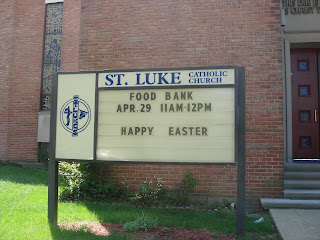Our Lady of Lebanon is a unique church in that it is a “Catholic” Church, but not a “Roman Catholic” church. The Maronite rite is one of many eastern churches that did not break with the Church of Rome during the Great Schism in the eleventh century. While they are still in communion with the Holy See, they are not part of the traditional church hierarchy. Rather than being under the jurisdiction of the Washington archdiocese, they are governed by a Patriarch in Antioch (who has a seat at the College of Cardinals) and belong to a local “eparchy” centered in Brooklyn, New York. Maronites are mostly found in the Levant, particularly in Lebanon.
I did some research on the Maronites before I went to Mass, and I got the impression that the service would be done in Arabic. I was worried that I wouldn’t know what was going on, but luckily I made some new friends, Ed and Mary, before Mass. They were both regular parishioners and they explained to me that the Mass would be performed in English and Arabic, with a few prayers in Aramaic, the language of Christ. They showed me how to follow along with the service in the prayer book and helped explain some of the Maronite traditions to me.
The church itself, according to Ed, was finished five years ago, and was the first church built in Washington, D.C. in about forty years. The building was all white, with a large steeple. The worship space was all white as well, with no decorations or paintings on the walls. The center of the church featured a glass dome, allowing sunlight to shine on the altar. The intention of this design was to give the church an austere feeling, with no extra decoration or ornament to distract from worship. Also, the sunlight at the front was intended to give the worshipper the feeling of walking out the darkness and into the light.
The fusion of Arabic and English into the Mass made for a beautiful service. The choir was made of about ten people in black and red robes, accompanied by a man on keyboard and two kids playing violins. Most of the hymns and chants were in Arabic, and they were beautiful. A female cantor did a solo chant at one point, and it felt like she was pouring her soul out into the church. In the Maronite Mass, there is only one reading before the Gospel. The reader asked the permission of the priest to read the Scripture, and, of course, he was granted it. The first man read in English, and then another man read the same passage in Arabic.
There were a few other noteworthy traditions at Our Lady of Lebanon, one of which was the abundant use of incense during the Mass. Another was the blessing of peace, during which Mary told me to put my hands together, and let an altar boy put his hands over mine, before shaking hands and wishing peace to those around me (Thank goodness Mary warned me, I would have had no idea!). The consecration of the host was done in Aramaic, and communion was only given on the tongue, because the host was dipped in wine before being presented to the worshipper.
The priest, Father Dominic, gave a wonderful homily. He started by talking about a boy in Sunday school who was asked to explain the fall of Adam in the Garden of Eden. Remembering only that the event had something to do with fruit, the boy guessed that Adam slipped on a banana peel. Father Dominic talked about how our mistakes, like slipping on a banana peel, may wound our pride and embarrass us. He said that Peter “slipped” many times during Christ’s life, doubting him and denying him three times when he was being persecuted. Yet when Christ returned and saw Peter face to face, he did not ask for explanations or apologies, and did not say “I told you so.” Christ only asked, “Peter, do you love me?” Peter may have failed, but none of it mattered to Christ. The most important question was “Peter, do you love me?” It was a great lesson for Catholics everywhere. Indeed, Peter did love Christ, and I must say that I loved Our Lady of Lebanon.
Links:
Our Lady of Lebanon Website
Eparchy of St. Maron of Brooklyn
Pictures:



Churches I've Been To So Far:
View Churches I've Been To So Far in a larger map










